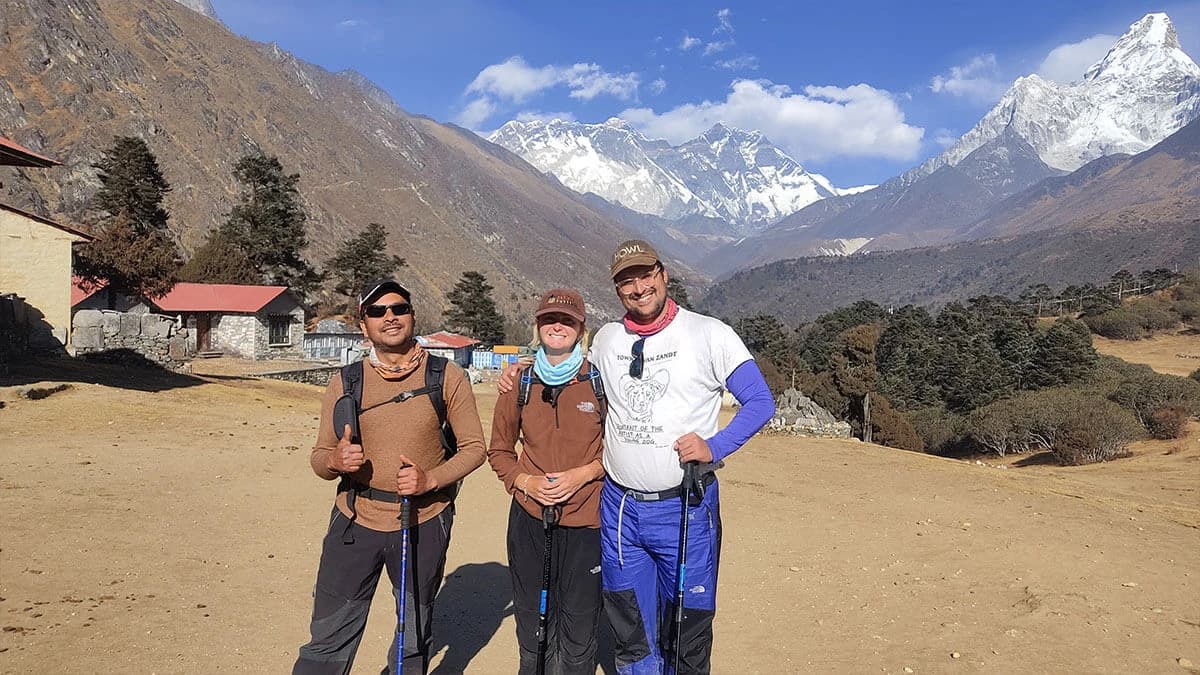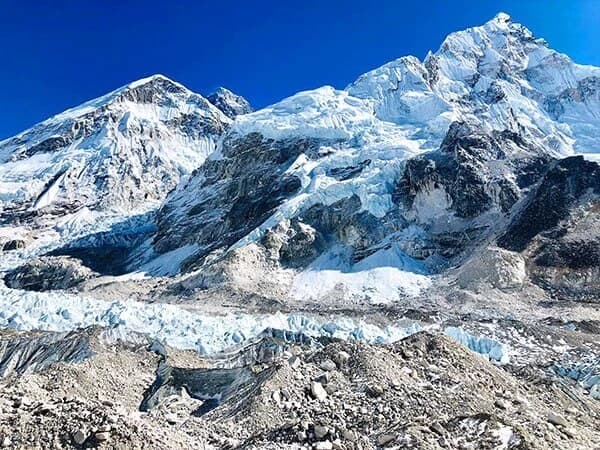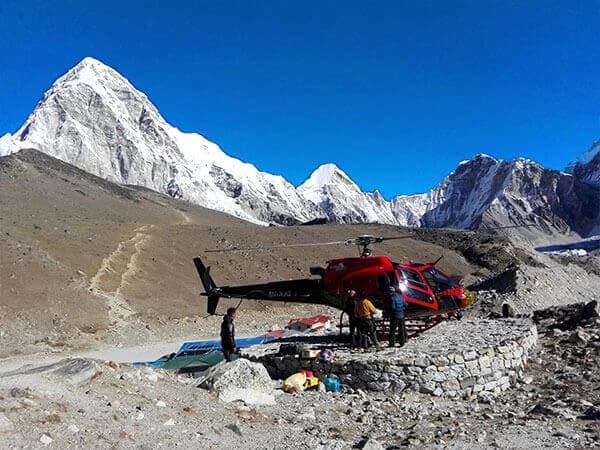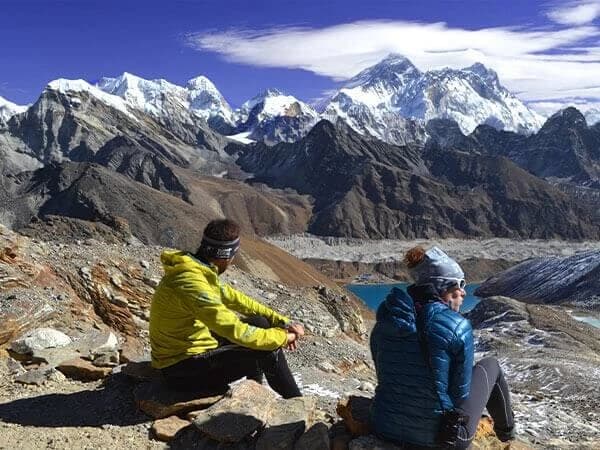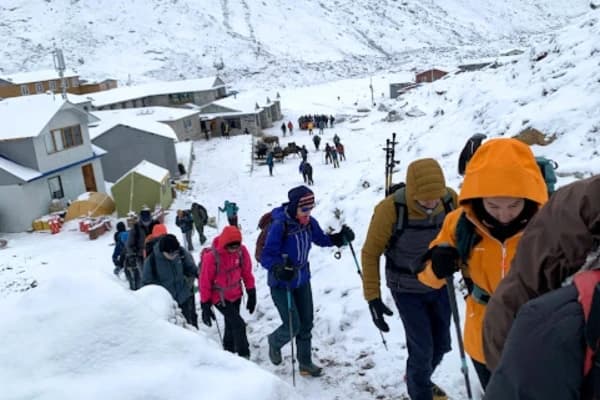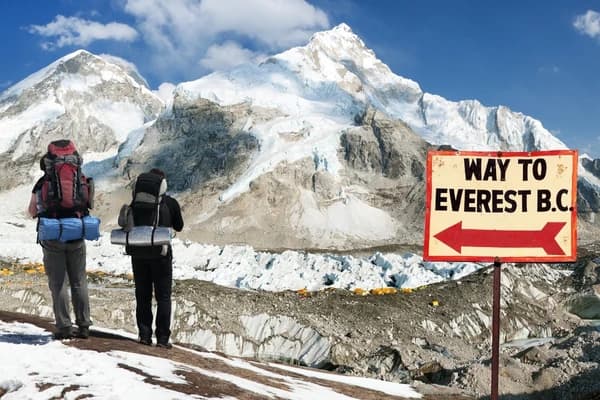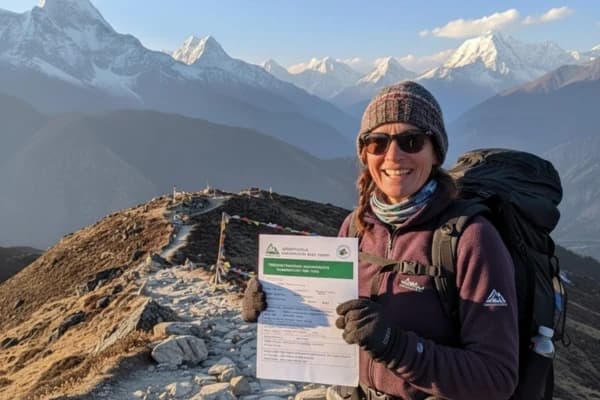The Everest region experiences four distinct seasons: spring, monsoon, autumn, and winter. Each season offers unique advantages and challenges, so it’s essential to understand what to expect during each period. Spring (March to May) and autumn (September to November) are the best times for the Everest Base Camp Trek.
Best Time for Everest Base Camp Trek
A once-in-a-lifetime experience, the Everest Base Camp Trek offers unmatched views of the highest peaks in the world. One of the most famous and sought-after trekking experiences worldwide is the Everest Base Camp (EBC) Trek.
The EBC Trek combines the breathtaking scenery of Mount Everest with the flora and fauna, icefalls, and glaciers. The Everest region offers numerous demanding trails, erratic danger, enormous mountains, striking scenery, and captivating experiences.
Highlights of the Everest Base Camp Trek
- Lukla Airport: Tenzing-Hillary Airport, the starting point of the EBC trek.
- Namche Bazaar: Sherpa Capital, gateway to the high Himalayas, and shopping hub.
- Tengboche Monastery: The largest monastery in the Khumbu region, offering stunning views of Everest and other peaks.
- Sagarmatha National Park: UNESCO World Heritage Site, offering breathtaking landscapes and panoramic views of the world's highest peaks.
- Khumbu Glacier and Icefall: Natural Wonders, offering a surreal experience of walking alongside massive ice formations.
- Kala Patthar: The best view of Mount Everest at 5,545 meters.
- Everest Base Camp: Final destination for climbers and mountain grandeur.
- Cultural Experiences: Sherpa hospitality and unique culture.
- Scenic Flights: Aerial views of the Himalayan range, including glimpses of Everest.
- Diverse Landscapes: Ever-changing scenery from lush green forests to barren rocky terrains.
Many people's dream adventure istrekking to Everest Base Camp (EBC), which requires careful planning. Although the Khumbu region offers unquestionably stunning views and the opportunity to stand at the base of the world's highest peak, the region's weather can vary greatly. Picking the right season is essential for your trek to be safe, enjoyable, and unforgettable.
The timing of your hike can significantly impact your experience. Over the year, there can be significant variations in the weather, trail conditions, and even the number of people. When is the ideal time to set out on this fantastic adventure? Let's examine the four seasons together and decide the best time to visit Everest Base Camp.

Everest Base Camp Trek in Spring Season (March to May)
- Weather: The Everest Base Camp Trek is most enjoyable in the spring. With clear skies and moderate temperatures, the weather is generally stable. At lower elevations, the temperature will be 10°C to 20°C. While at higher elevations, it drop down to -5°C to -10°C.
- Scenery: Vibrant rhododendron blooms adorn the landscape, lending a lively touch to the hike. Photographs of the mountains are breathtaking when visible in all their splendour.
- Crowd: Since spring is a popular trekking season, you'll likely run into more hikers on the trails and in teahouses.
Pros
- Stunning views of the mountains and spring blossoms.
- Lush greenery.
- Clear weather.
- The trekking conditions are reasonably comfortable.
Cons
- Increased costs for travel and lodging.
- More people on well-traveled trails.
Everest Base Camp Trekking in Summer/Monsoon Season (June to August)
- Weather: Significant rainfall occurs during the monsoon season, particularly in the lower regions. At lower altitudes, daytime temperatures range from 15°C to 20°C. While at higher altitudes, it can drop to 0°C to 5°C. The paths may be slick and muddy at times.
- Scenery: The region's abundant greenery reaches its pinnacle during the monsoon, providing a unique viewpoint of the Himalayas. But fog and clouds frequently block out views of the mountains.
- Crowds: The monsoon season is a quieter time to trek because there are fewer hikers around.
Pros
- Fewer crowds for a more personal experience;
- Vibrant scenery and lush vegetation (when the rain stops).
- Potentially cheaper airfares and hotel rates.
Cons
- There is a high chance of trail closures and landslides.
- Limited opportunities to see the mountains and poor visibility.
- Uncomfortable hiking conditions brought on by mud and rain.

Trek to Everest Base Camp in Autumn Season (September to November)
- Weather: It is thought that autumn is the ideal season for the trek to Everest Base Camp. The weather is stable, with clear skies and comfortable temps. At lower altitudes, daytime temperatures range from 10°C to 15°C. While at higher altitudes, they can reach -10°C to -15°C.
- Scenery: The mountains are beautifully visible during the post-monsoon season. With the clear visibility and crisp air, there are amazing vistas to behold.
- Crowd: As this is the busiest trekking season, there will be a greater number of hikers on the trails and in the teahouses.
Pros
- Stunning views of the Himalayas;
- Comfortable trekking conditions with warm days and cool nights.
- Vibrant colours of fall in the surroundings.
Cons
- Increased costs for travel and lodging
- More people on well-traveled trails.
Trekking to Everest Base Camp in the Winter Season (December to February)
- Weather: Winter brings chilly temperatures and snowfall on occasion, especially in higher elevations. At lower altitudes, daytime temperatures range from 0°C to 5°C. While at higher altitudes, they can drop as low as -10°C to -25°C.
- Scenery: The peaceful, snow-covered winter scenery makes for a memorable and peaceful trekking experience. The mountains are beautifully visible because of the frequently clear skies.
- Crowds: You can enjoy a more solitary and tranquil trek in the winter when there are fewer hikers.
Pros
- Fewer people mean a more private and tranquil experience;
- Stunning views of snow-capped mountains and winter scenery.
Cons
- Extremely low temperatures necessitate the use of special equipment.
- A higher chance of altitude sickness as a result of abrupt temperature changes.
- Restricted availability of some trails and lodging
Month-by-month breakdown overview of the EBC Trekking Season
- March: Rhododendrons are in bloom, with mild temperatures, more sunshine, steady weather, and fewer crowds.
- April: Increasing temperatures, bright skies, colourful paths, and unobstructed views of the mountains.
- May: With beautiful views and blooming vegetation, May marks the end of the spring trekking season.
- June: Lots of rain, high humidity, verdant surroundings, fewer hikers, muddy paths, poor visibility in the mountains, and possible flight delays.
- July: The height of the monsoon season, lots of rain, overcast skies, least amount of people trekking, lush scenery, challenging trekking conditions, high risk of landslides, and limited visibility.
- August: A lot of rain, a lot of humidity, peaceful trails, lots of greenery, difficult weather, and the possibility of delays and interruptions.
- September: Fewer people, clear skies, comfortable temperatures, and fresh air following the monsoon.
- October: Optimal trekking conditions, breathtaking mountain views, and exciting cultural festivals make October a great month to trek to Everest Base Camp.
- November: Clear and stable weather, fewer crowds, crisp views, and colder temperatures as winter draws in.
- December: Crispy snow-covered landscapes, fewer hikers, colder temperatures, and sporadic snowfall.
- January: The coldest month of the year, with severe winter weather, deep snowfall at higher elevations, bright skies, solitary hikes, bitterly low temperatures, and the possibility of snow-related disruptions.
- February: chilly, peaceful trails, unobstructed vistas, progressively warming weather, persistently low temps, and possible snowfall.
Weather Along the Everest Base Camp Trail
The weather along the Everest Base Camp trail can vary dramatically depending on the altitude, season, and specific location. Let's break down the weather patterns for different sections of the trail and across the four seasons.
General Weather Patterns
- Altitude: There is a noticeable drop in temperature as you ascend. At higher elevations, expect colder weather.
- Diurnal Temperature Variation: Particularly at higher elevations, there is a noticeable difference in temperature between the day and night. It is possible for days to be pleasant and nights to be icy cold.
- Precipitation: While snowfall is more frequent in the winter, rainfall is concentrated during the monsoon season (June to August).
Weather by Trail Section
Although the Everest Base Camp trek is all about high altitude conditions, there can be minor variations in the weather from one section to the next.
Lower Altitude (Lukla to Namche Bazaar)
- Enjoys a more temperate climate with evenings that are cooler and warmer days.
- Gets rain during the monsoon and snowfall on occasion during the winter.
Middle Altitude (Namche Bazaar to Dingboche)
- Wind speed increases and lower temperatures.
- There is more snowfall, particularly in the winter.
- Trails can become muddy due to heavy monsoon rains.
Higher Altitude (Dingboche to Everest Base Camp)
- Year-round extremely cold temperatures.
- Heavy gusts and a lot of snow, particularly in the winter.
- Little precipitation in contrast to other seasons.
Things to Consider While Choosing the Best Time for Trek to Everest Base Camp Route
Choosing the right time for your trek can significantly impact your overall experience. Here are key factors to consider:
Weather Situations
- Temperature: Take into account how much heat and cold you can handle. In general, high altitudes are colder all year round.
- Precipitation: Trails can become hazardously slick during rainy or snowy weather. Better visibility and a more pleasurable experience are provided by clear skies.
- Seasonality: There are distinct wet and dry seasons in some areas. You can avoid bad weather by being aware of these patterns.
Crowd
- Peak Season: This can be congested but offers better facilities and services.
- Off-season:Less crowded but possibly with fewer services available.
Trail Conditions
- Snow: Skiing in the winter often calls for specific equipment and knowledge.
- Muddy Trails: During monsoon seasons, trails may become slick and challenging to travel.
Price
- Peak Season: Typically, prices for lodging and travel are higher during this time.
- Off-season: Frequently has better prices.
Personal Preferences
- Scenery: Think about your favourite landscapes. Certain times of the year, like autumn foliage or spring blossoms, have unique natural beauty.
- Adventure Level: Winter trekking may be of interest to you if you like tough conditions. For those looking for a more laid-back atmosphere, spring or autumn may be better.
Specific Requirements for Trekking
- Permits: Certain treks call for permits, which may only be available during certain seasons.
- Local Conditions: Find out about any special occasions or road closures that might impact the trek you've selected at that time.
Lodging and Amenities
- Availability: There are typically more lodging options during peak season, but they may all be reserved. Options may be more limited in the off-season.
- Quality: Seasons have an impact on the standard of lodging. An increase in visitors during peak season frequently results in improved facilities.
- Cost: Seasonal variations in lodging rates apply.
Availability
- Transportation: Schedules for flights and ground transportation may be constrained during off-peak times.
- Trail Conditions: Depending on the season, snow or other weather-related issues may render certain trails impassable.
- Local Services: Depending on the season, guides, porters, and other support services may not always be available.
Reliability of Flight
The weather affects flights to and from Lukla, the entry point to Everest Base Camp:
- Spring and Autumn: Because of the steady weather, flight schedules are more dependable.
- Monsoon: Due to low visibility and rain, there are frequent delays and cancellations of flights.
- Winter: Possible hiccups because of snowfall and the environment.
Additional Considerations
- Altitude Sickness: Keep an eye on your health and take the appropriate safety measures, like drinking plenty of water and making a slow ascent.
- Emergency Services: Make sure you have access to emergency services, and think about getting high-altitude trekking covered by your travel insurance.
- Photography: Spring's blossoming flowers and clear skies, as well as autumn's crisp air and colourful festivals, provide wonderful backdrops for photos. The snow-covered scenery of winter also produces beautiful images.
- Physical Condition: The Everest Base Camp trek is a strenuous one, with weather conditions having a major influence on the level of difficulty. Select a time when you are most at ease and equipped to tackle the hike.
- Festivals and Cultural Events: Dashain and Tihar, two significant festivals that offer a distinctive cultural experience, fall in line with one another. There are a few local festivals in the spring that can improve your hiking experience.

Everest Base Camp Trek Gear Requirements according to Seasons
- Spring (March to May): Lightweight, breathable base layers, fleece jacket, waterproof and windproof jacket, trekking pants, shorts, warm hat, gloves, sturdy hiking boots, trekking poles, sunscreen, sunglasses, water purification tablets or filter.
- Summer/Monsoon (June to August): Waterproof outer layers, warm base layers, rain pants, hiking boots, trekking poles, rain cover, insect repellent.
- Autumn (September to November): Similar to spring, slightly warmer layers, waterproof jacket, trekking pants, fleece-lined pants, sturdy hiking boots, trekking poles, sunglasses, and sunscreen.
- Winter (December to February): Multiple layers of warm clothing, insulated pants, warm hat, gloves, neck gaiter, insulated boots, trekking poles, sunglasses, and sunscreen.
- General tips: Layering, waterproof gear, sun protection, headlamp, and water purification.
Making Your Decision
You can determine the ideal time for your Everest Base Camp adventure by taking these things into account, as well as your personal preferences. Here are a few instances:
- Choose Autumn (September–November) for gorgeous views of the mountains and comfortable weather, though there may be more people.
- Choose Winter (December–February) for a distinct and difficult winter experience with fewer tourists and cheaper prices.
- Choose Spring (March-May) for a pleasant trek with blooming wildflowers and fewer people than in Autumn, but be aware of possible early-season rain.
By carefully considering these factors and your personal preferences, you can select the ideal time for your trekking adventure.
Conclusion
The ideal time to trek to Everest Base Camp will depend on your experience level, preferred weather, and level of crowding. Due to their consistent weather and unobstructed views of the mountains, spring and autumn are the most preferred and well-liked seasons. But every season has its benefits and difficulties, so think about your preferences and plan appropriately.
No matter when you choose to set out on this amazing journey, the Himalayas' breathtaking beauty and the Sherpas' kindness will make it an experience you won't soon forget.
In addition, don't hesitate to contact Nepal Gateway Trekking with any inquiries you may have regarding the Nepal Everest Base Camp Trek or any other questions you may have about trekking in Nepal.
